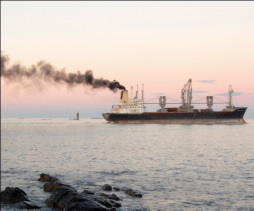EMBARGOED FOR RELEASE | August 20, 2012
Cleaner fuel for cruise ships and other big vessels from ingredients in detergents, medicines
Note to journalists: Please report that this research was presented at a meeting of the American Chemical Society.
PHILADELPHIA, Aug. 20, 2012 — Scientists today described development of a new fuel mixture to ease the major air pollution and cost problems facing cruise ships, oil tankers and container ships. These vessels tend to burn the cheapest and most highly polluting form of diesel fuel. Their report was part of the 244th National Meeting & Exposition of the American Chemical Society, the world’s largest scientific society, being held here this week.
George N. Harakas, Ph.D., explained that large ships have slow-speed engines designed to burn inexpensive, thick “bunker fuels” that literally are the bottom-of-the-barrel from the petroleum refining process. Bunker fuels are high in substances (such as sulfur) that produce air pollution, which creates a serious health and environmental problem when ships cruise along the shore or drop anchor in ports of heavily populated urban areas.
Media Contact
During Aug. 17-23 the contacts can be reached at 215-418-2086.
Michael Bernstein
202-872-6042
m_bernstein@acs.org
Michael Woods
202-872-6293
m_woods@acs.org
Harakas and colleagues from the Maine Maritime Academy and SeaChange Group LLC developed a fuel by adding two ingredients to low-sulfur diesel to produce “Bunker GreenTM” fuel, a member of the Eco-HybridTM family of fuels. One ingredient was glycerol, a thick, colorless liquid widely used in foods, medicines and other products. Glycerol is a byproduct of biodiesel production, making it a cost-effective, carbon-neutral and domestically sustainable fuel. Blending glycerol and diesel fuel is literally like trying to mix oil and water. The use of a surfactant, a class of chemicals similar to ingredients that boost the cleaning power of laundry detergents, was used to solve that problem.
The fuel they produced has improved emission properties and the potential to lower fuel costs for the shipping industry. Laboratory tests at the Marine Engine Testing and Emissions Laboratory (METEL) at the Maine Maritime Academy demonstrated that “Bunker GreenTM” fuel produced 15 percent lower emissions of soot-like particulates and 26 percent less nitrogen oxide pollutants. The International Maritime Organization (IMO) has recently passed regulations that call for tighter emission limitations for marine vessels operating near shore. This research into fuels with a lower environmental impact has been supported by the Maine Technology Institute, the National Science Foundation and private industry. Harakas concluded that “Bunker GreenTM” fuel could help the shipping industry reduce air pollution to meet these IMO regulations, especially for older ships.
To automatically receive news releases from the American Chemical Society contact newsroom@acs.org.
###

ships and other big vessels from ingredients in
detergents and medicines.

